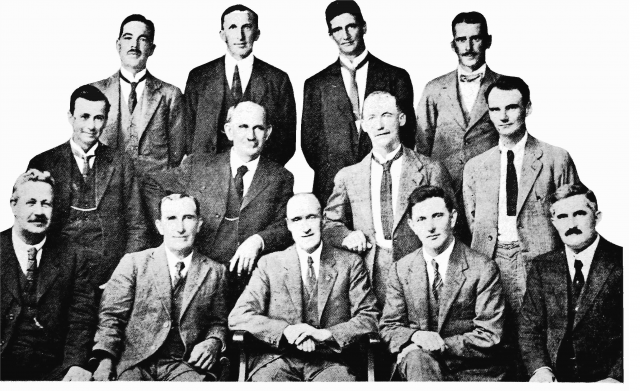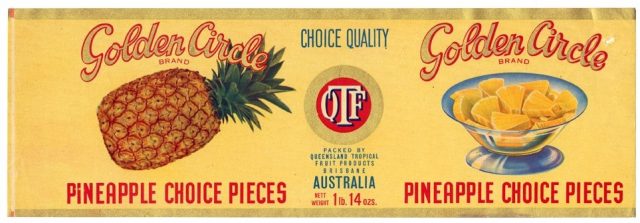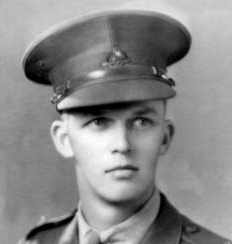By Gordon Plowman
Leslie Garforth Swain, known by his friends and associates as Les, could look back on his lifetime of achievements with pride and satisfaction. He gave of his time, effort and expertise and worked tirelessly for his community and the associations to which he belonged. Society today is built upon the influences of those outstanding men and women who came before us. As we will see, few could match the accomplishments of Les and Janet Swain.
Les and his wife, Janet, began farming in Flaxton prior to WW1, which puts them among the earliest settlers in the district. Their 26 acre, (10.5 hectare), farm consisted originally of an eleven-acre citrus orchard growing oranges and mandarins. Later, he put more of his land under cultivation and became a successful pineapple grower.
The Swains farmed in Flaxton for over 30 years during which time they brought up their family, daughters Janet and Margaret and son, John who became known throughout his life as Jock. Les and wife, Janet, contributed a great deal to the Flaxton and Montville communities and, over the years, Les built up an enviable reputation as a strong advocate for several fruit growers’ organisations. He continually sought new markets, better marketing methods and cheaper transport options at a time when the industry had little organisation and almost no government support. His never ceasing efforts to improve conditions for all Queensland fruit growers made him an icon within the industry.
Les was involved in so many things and organisations it is hard to know where to start. His main achievements were within the fruit growing industry and so that seems like a good place to begin.
Between the years 1910-1920, fruit production often caused a market glut, mainly due to poor market regulation and distribution. All fruit growers suffered lower returns as a result. Then, the government of the day introduced the Committee of Direction of Fruit marketing, known then as now as the C.O. D. The history of this organisation is long and complex but, in a nutshell, the C.O.D., through levies imposed on growers, attended to the orderly marketing and distribution of fruit. It also maintained standards relating to the packing and inspection of fruit to ensure a measure of quality control. While the structure of the C.O.D. remained substantially unaltered over its decades of operation, its powers have been adjusted in line with the changing times.
From the earliest days of its establishment, Les Swain was an influential figure. His input, in line with the wishes of the fruit grower’s associations to which he belonged, helped to build the C.O.D into an effective marketing organisation. He could, of course, take pride in his work but it wasn’t all plain sailing. At one time when fruit from southern markets flooded into Queensland forcing down returns to local growers, Les was called to a fruit growers’ meeting to explain the anomaly. His explanation must have been deemed satisfactory because he was subsequently voted into office at both the Flaxton and Montville Fruit Growers’ Associations in which capacity he served for the next 30 years.
As with all agricultural ventures, fruit growing experienced its share of ups and downs. In June, 1933, the Telegraph newspaper (Brisbane) reported the production for Flaxton as: 11,000 cases of citrus; 6,000 cases of pineapples and 850 cases of bananas. Although this was not a record, it did indicate a satisfactory crop yield for the year. Six years later in 1939, president of the Montville Fruit Growers Association, Les Swain, reported a difficult year due to an oversupply of fruit in the U.S.A. driving export prices down. Citrus growers suffered a further setback due to an exceptionally dry season.
As Les Swain and his colleagues who supported the C.O.D. learned from each experience, whether good or bad, they fine-tuned its operation to maximise returns to its members. In recognition of his exemplary service to the Flaxton and Montville Fruit Growers Associations, he was also elected to serve on the committees of the Pineapple Sectional Group and the Citrus Sectional Group. He now held responsible and influential positions within the most important fruit marketing establishments in Queensland.

First Committee of the Direction of Fruit Marketing, (COD)
Les Swain is third from the left in the back row. Image courtesy Diana Shogren, B.A., “The Creation of the Committee of Fruit Marketing”
At the Montville School of Arts in 1935, a large gathering assembled to recognise the years of service to the fruit growing industry by Les and Janet Swain. Les had represented the Montville and Flaxton fruit growers on countless occasions and had always fought to maintain the best outcomes for growers at the C.O.D. Those present were also keen to reward Les for his contribution in lobbying for better roads and cheaper transport and his unfailing efforts to hold land rates and valuations at fair and affordable levels. Mr. H. Smith (vice-president of the Fruit Growers Association), complimented Mr. Swain on his 16 years of service as President of the Fruit Grower’s Association, besides representing the district on the C.O.D. committee and also, looking after the district in regards to valuations and rates. T.H. Brown further complimented Mr. Swain and paid tribute to his wife, Janet, who, he said, had to sacrifice her husband’s company during his many absences.
On behalf of the Flaxton Fruit Growers, Mr. R.J. Perkins said, “Mr. Swain had always been in the forefront of anything for the welfare of the district. Mr. Swain had been a great helper in district matters and was an incentive to others to join in and assist.”
Mr. Lowe, chairman of the Maroochy Shire Council, said that Mr. Swain should feel that this was one of the proudest evenings of his life. He then Presented Mr. Swain with a pen and pencil set and a petrol reading lamp. He presented Mrs. Swain with a crystal jug and sugar basin.
Mr. Swain responded by saying he was very fortunate to have the goodwill with respect of such a representative gathering.
Following the 1935 presentations at Montville, Les continued his work with several fruit growers’ organisations.
During his years in office, Les witnessed many desirable developments within the industry. The manufacturers, Pope, Mayne and Southern, produced a simple and affordable, manually operated fruit grading machine which many a grower installed in their packing sheds. With their produce accurately graded, they could expect better market prices.
Rural schools began conducting courses relating to fruit growing, packing and marketing with the aim of educating young men and women in this field.
The Department of Agriculture encouraged schools to participate in fruit packing competitions. Both Flaxton and Montville State Schools competed for the John Macdonald and the Rowlands shields. As a twelve-year-old, Janet Swain, in a letter published in a Brisbane newspaper, spoke of her enjoyment as a competitor in fruit packing competitions. The widespread interest in fruit growing in the north coast regions is illustrated by an article in 1926, in the Brisbane Daily Mail:
“Eighty children from Buderim, Flaxton, Mapleton, Montville, Nambour, Palmwoods and Woombye, packed 160 cases of oranges in the competition for the John Macdonald shield. The report goes on to say: “The work done by the children was excellent, and some of the cases were arranged in exceptionally good style.”
One of the major developments in which Les Swain was involved in his role with the C.O.D., was the establishment of the Queensland Tropical Fruit Products Pty. Ltd., later known as Golden Circle. The Golden Circle cannery began production in its Northgate factory in 1947. In addition to fresh fruit markets in Australia and abroad, the cannery provided growers with another vital and necessary marketing outlet.

Golden Circle Brand of Queensland Tropical Fruit Products
(Image courtesy Queensland State Archives)
Flaxton school children of all ages had to walk three miles in all weathers along very poor roads to either Montville of Mapleton schools. A public meeting at Flaxton decided they should lobby the government to build a school locally but when the responsible authorities said they did not have the finances to do so, the Flaxton community decided to build it for themselves. Mr. and Mrs. J. C. Dixon donated one acre of their land and £50, to get the project underway. Flaxton residents, including the Swains, did all they could to drive the project to completion. After the school opened, Mr. and Mrs. Swain worked for the school committee and Les served from 1928 through 1930 as a committee member. Perhaps his most memorable moment took place in 1932 when he gave an eulogistic speech at the Flaxton school. The event was to commemorate Flaxton pioneers, Mr. and Mrs. J.C. Dixon, both of whom had passed on.
In the early days of settlement, the road connecting Flaxton and Montville wasn’t much more than a glorified goat track so it is likely that Mr. and Mrs. Swain would have either walked or ridden horses to the many events they attended in Montville. On a trip to Montville, they had to descend the steep slope near Skene’s property, proceed along the narrow range-top road with precipitous drops on both sides, then ascend the Red Hill before finally arriving at the township. On the way home they did it all in reverse. The steepness of Red Hill and its dirt surface made it almost impossible to negotiate after heavy rain and, in all weathers, it presented a dangerous hazard on its descent. Many accidents occurred here, some were reported, many were not. In 1934, Cyril McKillop’s vehicle rolled over a 50-foot embankment and the following year, a car skidded off the road and burst into flames in the lantana. The Flaxton Fruit Growers and Progress Association asked the R.A.C.Q. to erect a sign at the top of Red Hill drawing attention to the steepness of the grade. Unfortunately, the signage did not prevent the truck Clem Mobbs was driving from skidding out of control and rolling 300 feet (91 metres), over the side of the range into the Hunchy district. Clem escaped serious injury.
Considering the truly awful state of the roads it is little wonder that Les spent years lobbying members of the shire council to fix the worst parts. When council failed to respond, Flaxton residents did the work themselves and Les was almost always present at those working bees. Later, when motorised transport took over almost entirely from horse and buggy, negotiating the Flaxton to Montville Road could be a nerve-wracking experience but the steep and winding road from Palmwoods to Montville was positively scary. It took many years before the bituminised roads we enjoy today were finally completed.
At the outbreak of WW1, Les Swain applied to enlist in the A.I.F. but his application was rejected, probably because, as a producer of food products, his role was considered essential. He also had a young family to support. The Montville Memorial Gate carries the names of those who served and those who died during the war. Also inscribed are the six names of those local men who were rejected including the name, L. Swain. Feelings ran high during and after WW1, with a great deal of resentment towards those of eligible age who did not enlist. Making public the names of those who volunteered but were rejected, spared these men from the social pressures and humiliation current at that time.
An interesting turn of events in September 1930, raised the ire of Flaxton fruit growers. The Nambour to Mapleton tramway was running at a considerable loss and a by-law was being considered to mandate Flaxton fruit growers to transport their produce via the Mapleton tram, a move which would cost the growers more in transport costs and result in a later market delivery. Les Swain chaired the meeting where the overwhelming majority of those present opposed implementation of the by-law. In the final outcome, Flaxton growers continued to send their fruit via Montville to the rail head at Palmwoods.
Throughout his life, Les never stopped working toward the betterment of his communities and the many fruit growers’ organisations he represented. Somehow, he found time to do much more. He and Janet were active members of St. Mary’s Church of England (Anglican), church at Montville. He became president of the Montville Anzac Day committee; supported the Patriotic Committee, the Flaxton Progress Association, the Ratepayers Association and served on the committee of the Nambour Show society. After lending a hand at building the Flaxton school, he doubled up to support the building of the tennis courts at Flaxton.
Life wasn’t all work and no play. Les was present at the opening of the Flaxton tennis courts in 1923 and played fixtures there and elsewhere. He attended the Montville Masonic lodge, U.G.L.Q. 260, and in 1926, was installed as Master. He maintained active membership as Very Worshipful Brother Swain.
He loved playing bowls and was often to be seen on the Montville green and in competitions on greens elsewhere. As usual, Janet worked behind the scenes delivering many a delectable afternoon tea for the members and suppers on special occasions. Dr. Walters, president of the Queensland Bowling Association opened the new Montville bowling green in May, 1940. He proclaimed it to be situated at one of the most magnificent sites in Queensland. He went on to compliment the small band of Montville bowlers who had, through voluntary labour, brought the project to fruition. The thoughts of long-term member, Les Swain who had served as president then auditor, are not recorded but as he played one of the first games on the new green, he must have felt proud of this achievement.
Les Swain fully deserved the accolades afforded to him but his wife, Janet, also deserved her share. While bringing up her young family, she found time to lend her support to the building and, later, the running of the Flaxton school. For a time, she held the Flaxton Brownie pack together. As a foundation member of both the Montville and Flaxton C.W.A., she contributed many years of valuable service. During both WW1 and WW2, she redoubled her efforts and worked with other ladies to sew and knit comfort items for serving troops. As a member of the Red Cross, she worked both for the welfare of Australian soldiers during wartime and also to assist in local community projects.

Red Cross Poster WWII (Courtesy Australian War Museum)
DuringWW2, hundreds of thousands of women, like Mrs. Swain, took on voluntary work. Ladies of the Red Cross and the C.W.A. spent every spare moment they had, sewing and knitting items for the troops. Australian writer, Miles Franklin said, “All the women in our street are making pyjamas and socks to keep the men dressed.” A young mother wrote, “We did a lot of knitting for the Red Cross; I’d often put the children to bed and sit by the fire knitting.” The contribution made by these wonderful women is often overlooked. They deserve to be remembered for the incredible amount of work they did for the benefit of our Aussie soldiers.
Janet supported and worked with her husband in his committee roles with the Montville Anzac Day Committee and the Patriotic Committee.
Janet Uther Swain died in 1953, aged 79 years. She had spent over 40 years in Flaxton, and like her husband, she devoted much of her time to the service and welfare of others. Perhaps her greatest achievement was for all the years she had to manage alone while her husband was away, and the support she gave him in all his many endeavours.
Janet Marion, eldest of the three Swain siblings, was born in Nambour in 1913. The Flaxton school had not opened when she first started school and so she attended the Montville school, three miles (5 kilometres) away. Along with other Flaxton school children at that time, she probably walked to school and back. When the Flaxton school opened in 1922, she attended there.
After completing her schooling, she gained certificates in dress making and home nursing. Newly qualified, she found employment as a domestic science teacher at Nambour Rural School. Later, she accepted a transfer to Mossman in far north Queensland. In December of 1935, she made the long trip home for the Christmas holidays then, in 1936, took up a teaching post at Clifton Rural School on the Darling Downs.
She resigned her job as a teacher in 1940, at which time she was teacher in charge of the Travelling Domestic Science Car Number One at Texas, Queensland. Her resignation became necessary because she intended to marry and the regulations at the time excluded married female teachers from the profession unless they could prove extenuating circumstances. (These discriminatory regulations stayed in place until 1969 when they were finally abolished.) In March, 1940, Janet married Edgar Hiley and they settled in the Brisbane suburb of Tarragindi.
Margaret Gordon, born in July 1918, was one of the early attendees at the newly opened Flaxton school. In a published letter, she said the half mile walk to school was a pleasure. She passed the Junior Public exam in 1935 and shortly after, went to work on Waterford station near Capella in central Queensland as a governess. She continued there for several years, returning home to spend her holidays.
Anxious to do her part to assist the war effort, she joined the Women’s Air Training Corps in February 1942. She also did volunteer work connected with wartime activities.
In May 1943, she married Donald Chenhall in St. Mary’s Church in Montville. The married couple set up their home at Runcorn, Brisbane.
John Uther, always known as Jock, was born in 1915 and attended both the Montville and Flaxton primary schools. After completing his secondary education, he worked with his father on their farm. He participated in a number of sports including cricket, where he made vice-captain of a Montville team. He played tennis fixtures and served for a time as club president.
Jock joined the Commonwealth Military Forces (C.M.F.), designated as a part-time home defence army. The participants did their army training on weekends and at regular army camps held throughout the year. So, when Australia became involved in WW2, he had already undergone considerable military training and when he enlisted in the A.I.F., he was commissioned as Lieutenant and went with the 49th. Battalion to Thursday Island in 1941.
The Torres Strait Light Infantry replaced the 49th. Battalion and Jock, now promoted to Major, became the first commanding officer of that force of about 500 men. With a few exceptions, these were almost all from the Torres Strait. This was the only indigenous Battalion ever formed by the Australian Army. He served as commander from 1942 to 1944 at which time he became ill and was repatriated to hospital in Brisbane. During his stay there he met and later married Alison Peard.

Major Jock Swain, commander, Torres Strait light Infantry, 1942-44 (Image courtesy Torres Strait Heritage Museum)
Discharged from military service in 1944, Jock returned to Flaxton to help out on the family farm. Following in his father’s footsteps, he was elected to the executive committee of the Flaxton Fruit Growers and Progress Association and also took a keen interest in the Flaxton school and other community activities.
In yet another act of kindness to the community in 1948, as Flaxton residents prepared for connection to the 240-volt mains electricity supply, the Swains allowed Brisbane electrician, James McLennan, to use their packing shed as a base from which he could work to wire Flaxton homes and farms.
Jock later pursued business interests in and near Redcliffe where Rotary recognised his charity work and rewarded him as a Paul Harris Fellow.
At an “Australia Remembers,” ceremony on Thursday Island in 1955, Jock returned to meet surviving members of the Torres Strait Light Infantry. It was duly noted that the troops who had served under his command still referred to him as, “Major Jock.”
After a lifetime of achievements, Leslie Garforth Swain died in 1958, five years after the passing of his wife. Their three children, Janet Hiley, Jock Swain and Margaret Chenhall survived him.
A narrow country lane, not far from the bamboos on Mill Road, once ran from Flaxton Drive to Swain’s farm. The three Swain children would have walked and skipped and run along it every day on their way to primary school. Their parents would, on countless journeys, walk or ride or drive along the lane which always led them back home to their house below the green grassy hill to the west. The orange orchard and the pineapple plantation which once sustained a family for a lifetime is long gone, victim of unstoppable changing times. This is a good reason to remember the different Flaxton of old when men and women, girls and boys, endured the bad times and prospered in the good and where, in that small community, a helping-hand meant more then almost anything else on earth.
Swain’s lane is a memory lane now, one that leads us back to the farm, sometimes bathed in soft bright sunlight, sometimes when there is frost on the ground or a whistling wind rattling at the window panes, but always there is the feeling of the Swain legacy present, that ample capacity to do whatever needs to be done for the welfare of others.
*****
ACKNOWLEDGEMENTS:
Images:
The First Professional Committee of Fruit Marketing, 1923-24. “The Creation of the Direction of Fruit Marketing,” by Diana Shogren, B.A.
Queensland Tropical Fruit Products, Golden Circle. Queensland state Archives.
Red Cross poster, WW2. Australian War Museum.
Major jock Swain. Torres Strait Heritage Museum.
Sources:
Vetaffairs Magazine, July 1997
Australian Women at War. Anzac Portal, Australian Government Dept. of Veterans’ Affairs.
Newspapers:
Nambour Chronicle and North Coast Advertiser:
Feb. 1922. Nov. 1925. Sep. 1930. Feb. 1935. June 1935. Dec. 1939.
March 1945.
The Queenslander. Nov. 1925
The Week (Brisbane) Sep. 1933
Brisbane Telegraph Oct. 1953

 ©2016 Montville History Group. All rights reserved.
©2016 Montville History Group. All rights reserved.